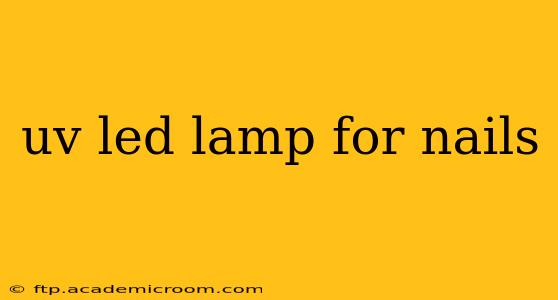The world of nail art has exploded, and a crucial element in achieving perfectly cured gel manicures and pedicures is the UV LED lamp. But with so many options available, choosing the right one can feel overwhelming. This comprehensive guide will walk you through everything you need to know about UV LED lamps for nails, from understanding the technology to selecting the best lamp for your needs and ensuring its longevity.
What is a UV LED Lamp for Nails?
A UV LED lamp is a specialized device that uses ultraviolet (UV) light-emitting diodes (LEDs) to cure gel nail polish. Unlike traditional UV lamps that use fluorescent bulbs, LED lamps offer several advantages, including faster curing times, longer lifespan, less heat generation, and energy efficiency. The UV light initiates a chemical reaction in the gel polish, causing it to harden and set. This process is essential for creating durable and long-lasting manicures and pedicures.
How Does a UV LED Lamp Work?
The process is straightforward: Gel polish is applied to the nails, and then the hand or foot is placed under the lamp. The UV LED light emits UV rays that interact with photoinitiators within the gel polish. These photoinitiators absorb the UV energy and trigger a polymerization reaction, essentially transforming the liquid gel into a solid, hard finish. The intensity and duration of the curing process vary depending on the type of gel polish used and the lamp's power.
What are the Different Types of UV LED Lamps?
Several types of UV LED lamps cater to various needs and budgets:
- Handheld UV LED Lamps: Compact and portable, ideal for travel or on-the-go touch-ups. However, they usually have lower wattage and smaller curing areas, potentially requiring longer curing times.
- Desktop UV LED Lamps: These offer a larger curing area, often accommodating all fingers or toes simultaneously. They typically provide higher wattage for faster curing.
- Professional UV LED Lamps: Designed for salons, these lamps often feature advanced features like multiple timers, adjustable intensity, and larger capacities.
What Wattage UV LED Lamp Should I Choose?
Wattage is a key factor affecting curing time. Higher wattage lamps generally cure faster, but they can also generate more heat. A good balance is usually found in the 36W to 48W range. Lamps with lower wattage (e.g., 9W or 12W) are suitable for thinner gel polishes or smaller areas, but may require longer curing times. However, some very high-wattage lamps can even risk damage to the gel or overheating.
How long does it take to cure gel polish with a UV LED lamp?
Curing times vary depending on the lamp's wattage and the specific gel polish brand. Always consult the instructions on your gel polish bottle for recommended curing times. Generally, expect curing times to range from 30 seconds to 2 minutes.
What are the benefits of using a UV LED lamp over a traditional UV lamp?
UV LED lamps offer several advantages: faster curing times, longer lifespan, less heat generation, and energy efficiency. Traditional UV lamps are bulkier, generate more heat, and have shorter lifespans.
How do I clean my UV LED lamp?
Regular cleaning is essential to maintain your lamp's hygiene and efficiency. Wipe the inside of the lamp with a lint-free cloth and a gentle cleaning solution after each use. Avoid using harsh chemicals that could damage the lamp's components.
Choosing the Right UV LED Lamp: Key Considerations
Before purchasing a UV LED lamp, consider these factors:
- Wattage: Select a wattage that balances speed and heat generation.
- Size and Capacity: Choose a lamp that comfortably accommodates your hands or feet.
- Timer Settings: Look for lamps with multiple timer settings for different gel polish types.
- Durability and Build Quality: Opt for a well-constructed lamp that will withstand regular use.
- Price: Prices vary widely; determine a budget that suits your needs and frequency of use.
With careful consideration and the information provided here, you can find the perfect UV LED lamp to elevate your at-home mani-pedi experience. Remember always to prioritize safety and follow the manufacturer's instructions for optimal results.
